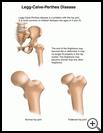
Legg-Calve-Perthes Disease (Hip Joint Problem)
________________________________________________________________________
KEY POINTS
- Legg-Calve-Perthes disease, also called Perthes disease, is a problem with the hip joint in children that occurs between the ages of 4 and 10.
- Treatment depends on how early the disease is found and how severe it is. Your child may need a brace or a cast to keep the hipbone in place, medicine to control pain, and physical therapy. Your child may need surgery.
- Ask your child’s healthcare provider how long it will take your child to recover from this illness, if there are activities your child should avoid, and when your child can return to normal activities.
________________________________________________________________________
What is Legg-Calve-Perthes disease?
Legg-Calve-Perthes disease, also called Perthes disease, is a problem with the hip joint in children. It usually happens to children between the ages of 4 and 10 and is more common in boys than girls. It usually happens in just one hip.
What is the cause?
This problem happens when the round end of the thighbone temporarily loses blood flow. The end of the bone may become flat or deformed. It may no longer fit properly in the hip socket. The thigh bone may become shorter than the other thigh bone. Healthcare providers don’t know why the blood stops flowing to this area or what causes blood to start flowing again.
What are the symptoms?
The symptoms often start with an ache in the hip or groin area. The pain can also be in the thigh or knee. It usually goes away when your child is resting. Your child may have some stiffness and may limp.
How is it diagnosed?
Your child’s healthcare provider will ask about your child’s symptoms and medical history and examine your child. Tests may include:
- X-ray of the hip
- An ultrasound, which uses sound waves to show pictures of the leg
- MRI, which uses a strong magnetic field and radio waves to show detailed pictures of the leg
How is it treated?
Treatment depends on how early the disease is found and how severe it is. Your child may need any of the following:
- A cast or brace may be used to get the weight off the thighbone and keep the end of the thighbone in the hip socket. This helps keep the bone in the hip socket until the blood supply returns. X-rays will be taken often to see if the bone is in the right place. If the bone is not kept in the right position, your child could get arthritis in the joint, and the joint may not work properly when blood starts flowing to this area again.
- Anti-inflammatory medicine may be given to reduce swelling.
- Surgery may be done to remove bone that has lost its blood supply and graft in new bone, or surgery may be done to realign the joint.
- Physical therapy may be needed to reduce pain.
- Exercises, traction, or other physical therapy may be done to restore the range of motion in the joint.
Your healthcare provider will need to see your child often to see if the top of the thighbone is getting more blood and growing again.
After 18 to 36 months, blood flow to the top of the thighbone usually improves and often returns to normal. Younger children generally have a better chance of full recovery.
How can I take care of my child?
Avoid high-impact activities like jumping or running while the hip heals. Try to find other activities your child can do. For example, swimming and gentle cycling are OK.
Ask your healthcare provider:
- How and when you will get your child’s test results
- How long it will take your child to recover from this illness
- If there are activities your child should avoid and when your child can return to normal activities
- How to take care of your child at home
- What symptoms or problems you should watch for and what to do if your child has them
Make sure you know when you should bring your child back for a checkup.
Last modified: 2019-12-23
Last reviewed: 2019-09-13

